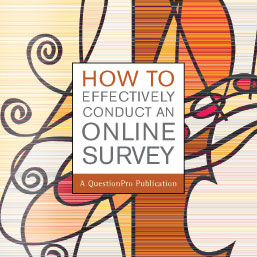Semantic Differential Scale - Measuring Customer Attitudes
For decades, market researchers have relied on Semantic Differential Scale to obtain accurate data on respondent's attitudinal feedback. Though it seems complicated, Semantic Differential Scale is a scale that measures the gray area between two possible connotative meanings of things.
‘Connotative’ refers to the feeling or emotions associated with the word. So it’s a simple question of a respondent’s position on a scale between two bipolar adjectives that measures the connotative feeling on a particular subject matter. For example, if evaluating someone on their emotional well-being, the first adjective is ‘Sad’ while the other adjective is ‘Happy.’ The user is left with the option to take a position only from the given bipolar adjectives.
Fundamentals of Semantic Differential Scale
Semantic Differential Scale was created by Charles Osgood in 1957 to measure the meaning of objects, events, and concepts. The core elements of semantic differential scale include the concept that is being measured, a negative polar, a positive polar, and a scale connecting both polar adjectives. This gives the respondents the unique benefit to fully express their opinions about the concept.
Because the survey question is based only on two antonyms, an adequate response relies on the respondents having a good understanding of linguistics. The Semantic Differential Scale is one of the most appropriate techniques used to understand the intensity and direction of conceptual meanings. This is particularly useful with those concepts that are more complex, as the scale poses a great advantage to any field with the potential of having very diverse perspectives. The semantic differential can deteriorate perceptions, beliefs, or attitudes regarding intangible or even invisible system characteristics into separate concepts. In addition, it also reduces survey completion time because respondents do not feel pressured to make their declarations definitively about a concept unless that is their immediate reaction.
Creating a Successful Semantic Differential Question
The first step toward creating a Semantic Differential Question is choosing a concept to test. For example, a test can be carried out to measure customer satisfaction on a product. From there, decide on the best bipolar adjectives that describe the experiences that customers could be having.
The next step is to ensure that the questions highlight the main concepts that were previously chosen and which the semantic scale ultimately surveys.
The three main components we look to test using Semantic Differential Scale are strength/potency, value/evaluation, and activity. Each of these three major dimensions can be surveyed using a scale with polar opposite words. For example, ‘Decisive’ versus ‘indecisive’ can assess strength with two polar opposite adjectives. Perception of value or the evaluation of a product or service can be tested with ‘cheap’ versus ‘expensive’. ‘Lazy’ used as the opposite of ‘industrious’ can assess the activity. These three concepts together can reveal a respondent's perspective on a certain concept.
The Logistics of Semantic Differential
How about we pretend you just joined a new gym - congratulations! New year, new you! You even splurged and decided to get a personal trainer to really amp up the ante. After a few weeks of rigorous training, the gym’s general manager wants to figure out how your experience with your performance coach is going by asking the question below.
As you can see in Fig. 3, the sample question above, there is an adjective on the left followed by 7 radio buttons and the opposite adjective on the right. The two adjectives, focusing on the first line, are ‘Knowledgeable’ and ‘Ignorant’. These adjectives are polar opposites and measure the dimension of strength. We are not, in this case, asking you to definitively call your performance coach ‘knowledgeable’ or ‘ignorant’, unless of course, you feel that is accurate. Instead of a black or white selection, you will find seven different options that allow you express your opinion of the performance coach based on a scale. This scale allows for a ‘gray’ area and the opportunity to have variation in your answer.
Organizing Your Question
The next thing to note about the diagram is that the perceived positive words should not all be on the same side. In this case, ideal answers become more obvious to respondents, which can bias results when some subjects feel that they need to give socially acceptable answers. Placing all of the positives and negatives on the same respective sides of the scale will make recognizing the desirable answers easier. If subjects choose to distort their responses towards social desirability, the evaluation scores would be biased upwards. This **Survey Template** illustrates this technique.
Know Your Audience
The example question below shows a range of radio buttons that are not numerically labeled; this is known as ‘scale points unlabeled.’ As one of three ways to create a scale for semantic differential questions, using a scale point unlabeled also assumes that the audience is proficient in abstract thinking.
If the population being surveyed has the numerical aptitude, then labeling the buttons with a number would be appropriate. This simply gives subjects a reference point as labeling the center radio dot with a ‘zero’ shows the neutrality between the two adjectives. The semantic differential scale is a question type that allows rating an amount of a trait or quality of an item. The option to be neutral allows the person responding to opt out of assigning either quality to that item. In the case of our example, we think the performance coach is neither encouraging nor discouraging, so a “0” rating was chosen, smack dab in the center representing neutrality.
The third way to label the questions is ‘scale points labeled,’ which is considered the best way to label the scale for the general public. This scale ranges from undecided in the middle, to strongly agree or disagree toward the respective positive adjective and the negative adjective.
Analyzing Semantic Differential Data
After conducting the surveys, undoubtedly, you will want to unearth your findings and analyze your survey data. Below, you can see the data we collected from our example survey about the performance coach.
This particular gym chose to look at how well their performance coaches ranked on the following bipolar adjectives—-knowledgeable/ignorance, happy/sad, strong/weak, active/lazy, spontaneous/routine, strict/relaxed, encouraging/discouraging, demanding/relaxed, and energetic/passive. A +3 rating is the highest score the performance coach can achieve, which means a respondent marked “Strongly Agree” on the positive adjective (also a 3 or the radio button closest to the adjective depending on your labeling system).
After charting the collected data, the gym’s managers can ascertain the qualities in which the performance coach excels and where there is a need for improvement, from the client’s perspective.
Conclusion
The semantic differential scale is mainly used to help researchers understand their respondents’ perspectives on a concept. From their customer’s experience to the effectiveness of their new performance coach, the scale leaves space for gray area. In addition to quicker completion times for the respondents, the goal of the survey is to gain a better understanding of the three main components of any given concept, strength, value, and activity. When creating the survey, it’s also important to have an understanding of who will be answering the questions so that the scale metrics are easy to understand. The goal of better understanding your consumers is attainable thanks to the semantic differential scale, which is why researchers find it such an effective and useful question type.
 Survey Software
Easy to use and accessible for everyone. Design, send and analyze online surveys.
Survey Software
Easy to use and accessible for everyone. Design, send and analyze online surveys.
 Research Suite
A suite of enterprise-grade research tools for market research professionals.
Research Suite
A suite of enterprise-grade research tools for market research professionals.
 CX
Experiences change the world. Deliver the best with our CX management software.
CX
Experiences change the world. Deliver the best with our CX management software.
 Workforce
Create the best employee experience and act on real-time data from end to end.
Workforce
Create the best employee experience and act on real-time data from end to end.











